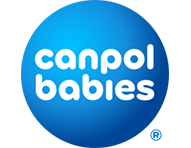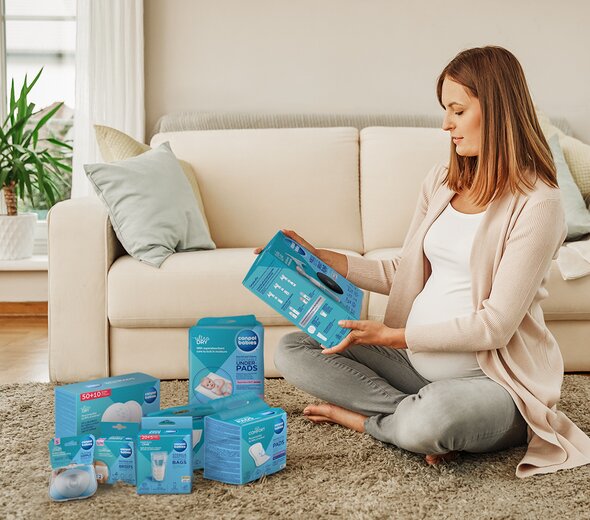

Not sure how to prepare for the birth of your little one and what to bring to the delivery room? We will tell you what your hospital bag should include and how to prepare for labour. Follow the advice of experienced mums and pack your hospital bag with us.
As a mum-to-be begins the third trimester of her pregnancy, she should start putting together a starter kit for her and the baby. One of its important elements is a list of items to pack for labour. A well-packed mum’s hospital bag gives parents peace of mind and security. This is why it is worth having a checklist of the essentials in your hospital bag.
Contrary to what you might think, there is a lot of stuff for the hospital, so it is worth preparing a suitcase with two compartments or a large travel bag. A suitcase is much more convenient, as you can pack the items for a mum in the first compartment and the ones for a baby in the second compartment. It will help you find yourself in the new reality after giving birth, where everything will be new and will seem difficult.
Although most mums buy things for the baby first, don’t forget about the items for you. After your baby is born you will need the following products:
This is a must-have product in your hospital bag. Midwives recommend elastic, reusable mesh maternity briefs. Why? Because, thanks to their permeability, the panties provide proper airflow needed for perineal healing after childbirth. Postnatal panties support a postpartum hygienic pad or a pad, allowing the mother to be active during the postpartum period.
Advice from Katarzyna Orawiec-Rymszewicz*, a midwife: In the first few days after a natural childbirth it is best to stock up on mesh underwear. Such underwear lets air into the wound and reduces the risk of the sutured area being chafed by the material.
In the following days, wear panties made from natural materials and avoid non-breathable underwear. During the recovery of the perineum avoid tight trousers, like jeans. It is more comfortable and healthier to wear leggings (e.g. the ones you wore during pregnancy) or skirts/dresses.
Check our multiple-use breathable maternity briefs.
Postpartum hygienic pads are more absorbent than normal menstrual pads and are excellent at absorbing postpartum faeces. It is worth choosing pads with an adhesive strip and wings that prevent the pad from moving and protect the edges of the underwear. The pad’s filling should absorb liquids quickly and retain moisture in the pad. The outer layer of the pad should be made from natural fibres, it should not delaminate or stick to the skin. This ensures free airflow and protection against irritation.
It is best to stock up on both the day and night version of postpartum hygienic pads. The night ones are even more absorbent.
Learn more about postpartum pads for day.
Check postpartum pads for night.
Postpartum pads are thinner than postpartum hygienic pads, but they are more absorbent than regular pads. They ensure comfort. They work well in the latter days of the postpartum period or for those mums whose postpartum faeces are smaller.
Advice from Katarzyna Orawiec-Rymszewicz*, a midwife: change your pads regularly to avoid infection (every 3-6 hours or more often if necessary). Remember that the amount of discharge during the postpartum period and its duration is a very individual thing.
Learn more about postpartum pads with wings for day.
Check postpartum pads with wings for night.
It's a must-have in your hospital bag, ensures comfort and hygiene for a breastfeeding mum. You only need one small packet of the pads in your hospital bag. Initially, drops of colostrum will be coming out of the breasts, followed by small amounts of milk. Usually, milk comes in on the third day after labour and then the pads prevent underwear from getting wet with milk.
What to look for when choosing the pads? Choose the ones that have a moisture-retaining filling, an adhesive strip (preferably a double one), holding the pad in the bra, are shaped and have soft edges.
Advice from Katarzyna Orawiec-Rymszewicz*, a midwife: Maintain good breast hygiene and change the pads regularly to avoid the risk of inflammatory conditions on the nipples.
Discover the advantages of 3D breast pads.
Although some mothers think they won't need a breast pump in a hospital, many patients use it in the first few days after labour to kick-start lactation after a caesarean section, to give their milk to a premature baby or to collect milk for later, when a baby is sleepy after birth and won't suck. A breast pump is also a mother's ally in the fight against the first lactation problems, such as flat or concave nipples, overabundance or shortage of milk, or mastitis. That is why you should include it in your hospital bag.
You can choose between a single or a double breast pump. A double breast pump is recommended for mothers of premature babies, twins, those planning a BD (breastfeeding differently) or to return to work or university quickly and give their baby their milk while they are away.
When choosing an electric breast pump, pay attention to whether it is two-phase (similar to natural suction), can work without power supply (rechargeable or regular batteries), whether it has adjustable suction power and a massage cushion.
Pack 2 maternity shirts and a couple of unbuttoned postpartum nightgowns, and nursing bras in your hospital bag. It is possible that your bra and shirt get wet with breastmilk during a feed, so it is important to have backup.
A well-fitting nursing bra should be made from natural materials. The best one is cotton, as it is breathable. A bra should have wide straps, detachable cups and adjustable width. This ensures the bra fits the circumference of your ribcage.
This product is recommended for mums who have concave, flat, nipples retracting during feeding. Silicone nipple protectors also work well when a baby has a high-arched palate and cannot grasp the nipple. You should discuss the selection of the nipple protectors with your midwife or lactation consultant. It is important to adjust the diameter of the protectors to the width of the nipples.
Look at silicone breast shields and learn about the advantages of the product.
After labour the breasts are often irritated or cracked after feeding. If this happens, apply an ointment with lanolin that you do not have to wash off before feedings.
Remember to air the nipples as often as possible, wear breathable underwear and loose blouses at the beginning of breastfeeding, when the nipples are irritated. You should rub the nipples with your own milk after feeding.
Advice from Katarzyna Orawiec-Rymszewicz*, a midwife: Lanolin lubricates and improves skin elasticity. Reduces dryness of cracked nipples. Heals and reduces pain and discomfort during breastfeeding.
Check the benefits of the lanolin cream.
Pack your reliable feminine hygiene products that do not cause allergies or irritations. You should also pack paper towels for wiping the perineum.
WHO recommends eating and drinking during labour. Water and snacks will also come in handy for the dad during birth.
Once you know what to pack for the hospital and buy everything, you should prepare your bag 4 weeks before the planned labour. The baby may arrive earlier. The last few weeks may be different and you may need to go to the hospital earlier and wait for the labour there. Packing your hospital bag in advance gives you a sense of security and reassurance that you haven't forgotten anything and are fully prepared for the first moments with your little one.
*Katarzyna Orawiec-Rymszewicz, a midwife, a breastfeeding educator.